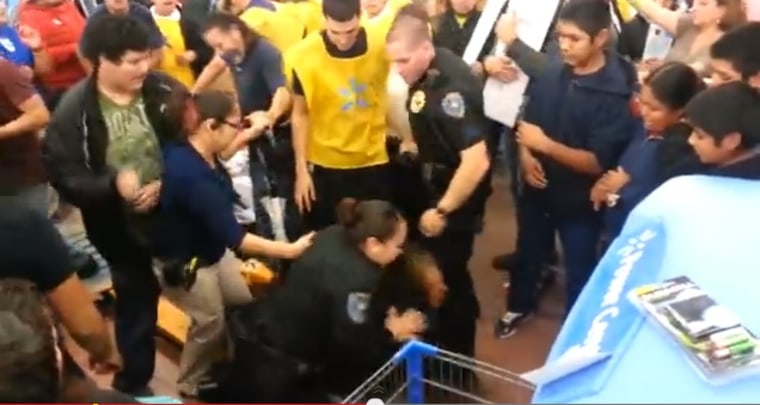Black Friday weekend sales may have been down a disappointing 2.9 percent this year, according to a survey from the National Retail Federation — but Black Friday shopping fights were booming, at least on social media.
Thanks to fresh new video-sharing via Instagram and Vine, not to mention good ol’ YouTube, those of us who abstained from turkey-stuffed bargain hunting got to see such hypnotizing scenes as a three-way hair-pulling fight at a Wal-Mart customer service desk. We saw punches thrown over discount DVD players, a display case collapsing under customer siege, and cops tackling and cuffing the most aggressive bargain hunters. We heard a beleaguered clerk-turned-drill sergeant command checkout lines to “Move to the right! MOVE TO THE RIGHT!” And a woman claiming “heart problems” as she admonishes a fellow customer, “You pushin’ people like you crazy!”
Those of us relying on smartphone-equipped citizen shoppers to share such scenes of retail carnage clucked our tongues on Facebook and Twitter and lamented for humanity, as if bad behavior is new and we didn’t enjoy feeling superior. We shrugged off the classist subtext that makes us laugh at photo-mocking website People Of Wal-Mart, maybe telling ourselves it’s OK to laugh at Twitter-trending #WalmartFights because we’re laughing at the embattled corporation, not the humans who work and shop there. Or maybe we were just reminded that the human condition is frickin’ hilarious.
Bad behavior — on both the shoppers' part and the part of those who enjoy social media schadenfreude — is nothing new, especially when it comes to this annual family pastime. Black Friday has always been a blood sport, but social media gives it a wider audience.

“Nothing says pre-Christmas Wal-Mart shopping like being handcuffed on top of the flatscreen television that you were fighting over,” Gawker commenter “Alexander Corouton-Skitch,” observed under one of the Internet’s many #WalmartFights compilations (thoughtfully including a .gif of the titular scene). And hey, he’s got a point.
“Certainly, social media has brought [Black Friday behavior] to our attention,” said Amy Kilgard, a communication studies professor at the San Francisco University. Kilgard, whose own performance art and research focuses on consumerism, knows a thing or two about Black Fridays, having experienced her fair share as a Target clerk. “These are the kind of fights people have at big-box stores, going back years and years to Cabbage Patch dolls,” aka the Tickle Me Elmo of the 1980s.
For all the hype around the hashtag, Wal-Mart reports a record low in Black Friday incidents. "The hashtag perpetuated itself," Wal-Mart spokesperson Brooke Buchanan told NBC News. The impression that each and every store contained some sort of Black Friday melee ran contrary to the "record drop" in this year's reported Black Friday "incidents,"— less than 10 kerfuffles required police intervention, Buchanan said. "With 22 million people coming through our doors and with over 4,000 locations, we're really proud of our team and the safety plan we executed very well."
To prevent the rush on limited deals, Wal-Mart distributed wrist bands allowing in shoppers between certain hours, which reserved limited-time bargains, and spread out popular electronics in areas that don't get a lot of Black Friday traffic, like the freezer section.
But Black Friday stopped being about bargains a long time ago — sales take place year-round, you can bargain-hunt on the Internet even if it isn’t #Cybermonday and have your giant flat-screen delivered directly to your home. But retailer hype and subsequent media coverage have made Black Friday shopping an event bargain hunters won’t miss even if Amazon really does start delivering by drone.

“It’s like the Super Bowl,” says Thomas G. Plante, a psychiatry professor at Santa Clara University and Stanford University. “Whether you like football or not, this is what you’re supposed to do — eat party foods and watch TV even if you don’t care about the game,” explains Plante, who recently wrote about "The Absurdity of Black Friday," in his Psychology Today column.
Yup, agrees Laura Portwood-Stacer, assistant professor of media, culture, and communication at New York University's Steinhardt School of Culture, Education and Human Development. Black Friday shopping “has become a cultural ritual,” she told NBC News. “People do it with their families. They talk about it with fellow consumers. Consumerism is the basis of our culture; it’s how we relate to other people.”
These days, you can participate in this cultural ritual from the comfort of your smartphone. As for the amateur videographers recording the kerfuffle for social media so that we may pass judgment from a safe distance, yes, they have their own motivations, too.
“Social media is as much about information and communication as it is about performance and identity,” Portwood-Stacer said. “So people are really saying something about themselves when they post videos, ‘Maybe I go out for Black Friday but I’m not as bad as those people.’”
Helen A.S. Popkin is Deputy of Technology & Science editor for NBCNews.com. Join her, won't you, on Twitter and Facebook.